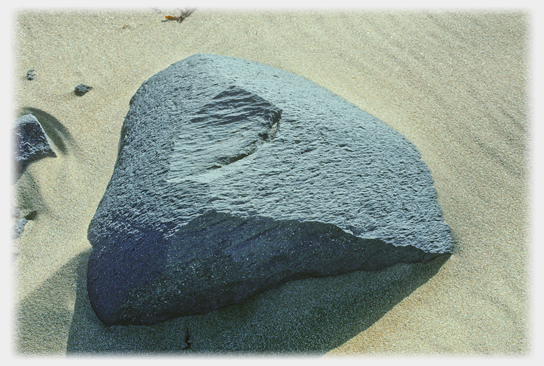
|
Russian Nesting Objects
Setting aside nesting Russians, this is a picture of an object, a boulder, a perfectly ordinary boulder. It is clearly a picture of one boulder, not two, or many. It is exactly what we mean by one object. However, clearly the picture is not the boulder, so there is both the picture and the boulder. Well, of course, but it is the boulder 'itself' which remains one. Immediately the boulder is withdrawing from us. What is this boulder 'itself'? This page approaches that question concretely; 'Many Worlds' follows a more academic line.
We can imagine a series based on the picture above, which goes as follows:
(A) The boulder in the picture has a chunk removed from the top, it could mean it was used to make an axe head, this is not a serious suggestion, but should it have been so, then the boulder would have a place in a culture as a source of material, and as such the boulder would have significance and meaning within that culture.
(B) Whether or not it has any cultural significance this boulder is, in any case, an example of what we mean by the word 'boulder', and we can label endless other similar boulders; this is a linguistic counterpart to the boulder, and let's us talk with other people about boulders.
(C) Then again this boulder is one among many on the beach, without language we can still walk among them, sit on them, and experience them; those are perceived boulders.
(D) Behind my intention to go and sit on my perceived favourite boulder lies the sensations of doing so; the visual object that I do not fall over, the feel of the stone to my touch, and the sounds associated with it. These occur before I come to see it as a single object which I can have as an intended part of my life.
(E) Beyond the sensations, deeply hidden from us, is the boulder of physics which gives rise to those sensations, the boulder that we know is more than 99.9% space, the boulder that has no colour of itself, and no hard edges that distinguish it from its surroundings.
(F) Finally we might want to add that there is that which gives rise to the hidden boulder, Kant calls these the
noumena,
and about this we can say nothing.
Our world is filling up with boulders. So how many are there? The list could only be made by presupposing one boulder, so it would be odd to then ditch that unity. But each of those boulders is potentially separable, each might have been without the others, stories might run along the lines of a trompe l'oeil painting, a stone never seen, 'boulder' as a word like unicorn with no reference, and so on. Like Russian nesting dolls (matryoshka dolls) there is a set that belongs together, although each member may live an independent life, should fate (or philosophic imagination) decree it so.
What is important is the viewpoint and the context. We approach the boulder in many ways, and each way elicits a different guise. Rather in the way that the framing of a question directs the type of answer we receive, so there is no one boulder 'itself' anymore than there are many boulders. These wanton vacillations on the part of objects give our poor minds much to pause over.
References
- Nagel, Thomas (1986) The View from Nowhere. OUP
17th May 2015 ~ 25th July 2015